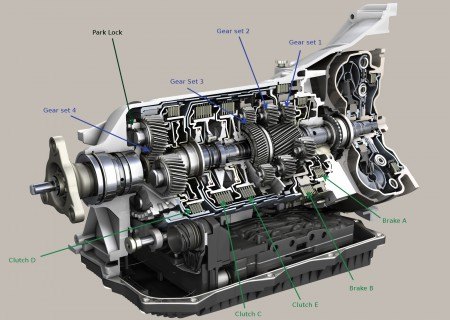Editorial: Three Cheers For Eight Speeds
In the annals of automotive history, there is a litany of ill-fated replacements to improve upon the manual gearbox. From Citroen’s semi-automatic gearbox in the DS, to the Tiptronic system of 1990’s Porsches, the attempts by various manufacturers to offer the performance and driver engagement of a manual with the ease and convenience of an automatic have universally failed. For a time, it looked as if the dual-clutch transmission had finally achieved this synthesis, but outside of performance applications, they proved disappointing. Balky starts, jerky shifts and a reputation for sub-par reliability marred the adoption of these units. It looks as if the great equalizer has come in the form of a tried and true torque converter automatic transmission.
The ZF 8-Speed automatic has proven to be exceptional in every single application. From the BMW X1 to the Jaguar F-Type to the Dodge Charger Hellcat , the ZF unit has a remarkable ability to perfectly adapt to whatever driving conditions are at hand. In traffic it shifts imperceptibly, while on the highway it lets the engine hum along at RPMs that ensure relatively miserly fuel consumption.
When its set for performance, shifts are snapped off in such a rapid manner that even the best dual-clutch units from Volkswagen and Porsche would be hard-pressed to claim a qualitative edge. In certain applications, like the Hellcat, it’s downright violent when the appropriate settings are engaged – yet it can still return 22 mpg on the highway.
There is one thing that a two-pedal transmission can never replicate, and it’s not the purity of the driving experience, the bragging rights of owning a manual or even the increased engagement with the car. It’s the rhythmic motion of working the clutch and the gear lever, and it’s what keeps me coming back to the stick shift. I find it incredibly relaxing, even in the worst stop and go traffic. On an open road, there is nothing better than pressing the clutch, moving the shifter into its gate, feeling the mechanical precision, letting the clutch out and watching the revs fall back to the appropriate RPM.
But my mindset changed when Jaguar announced a manual F-Type V6S (my favorite variant of the range). The prospect of a three-pedal setup didn’t seem as enticing as flicking a paddle, hearing the burble and pop of the exhaust and feeling the infinitesimally rapid *thud* in my back as each shift propelled me forward.
But I’m not in the market for an F-Type. Or any car that uses the ZF 8-speed auto. My next car will more than likely three pedals. I can’t imagine it any other way. Unless I get a MK7 Golf R. I’ll explain later this week in the full-length review.
More by Derek Kreindler
Latest Car Reviews
Read moreLatest Product Reviews
Read moreRecent Comments
- Jeff Self driving cars are not ready for prime time.
- Lichtronamo Watch as the non-us based automakers shift more production to Mexico in the future.
- 28-Cars-Later " Electrek recently dug around in Tesla’s online parts catalog and found that the windshield costs a whopping $1,900 to replace.To be fair, that’s around what a Mercedes S-Class or Rivian windshield costs, but the Tesla’s glass is unique because of its shape. It’s also worth noting that most insurance plans have glass replacement options that can make the repair a low- or zero-cost issue. "Now I understand why my insurance is so high despite no claims for years and about 7,500 annual miles between three cars.
- AMcA My theory is that that when the Big 3 gave away the store to the UAW in the last contract, there was a side deal in which the UAW promised to go after the non-organized transplant plants. Even the UAW understands that if the wage differential gets too high it's gonna kill the golden goose.
- MKizzy Why else does range matter? Because in the EV advocate's dream scenario of a post-ICE future, the average multi-car household will find itself with more EVs in their garages and driveways than places to plug them in or the capacity to charge then all at once without significant electrical upgrades. Unless each vehicle has enough range to allow for multiple days without plugging in, fighting over charging access in multi-EV households will be right up there with finances for causes of domestic strife.


































Comments
Join the conversation
I have a bad left knee so no more manuals for me, especially since I live in an urban area. No more DSG's either. I bought both a Fiesta and a Focus because of that new technology. Both have had to be rebuilt. Powershift has become as shameful a word to Ford as Edsel. I wonder how many of these Ford has had to pull and rebuild. Some people have had to have clutch packs replaced 3 times.
No more DSG's for me. I bought both Focus and Fiesta Powershift DSG. Both have had to be yanked out and have clutches replaces. Powershift may be as big a tragedy to Ford as Edsel.